

As summer approaches, the annual ritual of vacation planning begins. For many, this means dreaming of destinations that offer a distinct break from the everyday. But as you map out your getaway to a bustling resort, a vibrant theme park, or a luxurious cruise ship, consider a curious paradox: for many who cherish the quiet, car-dependent lifestyle of the suburbs, the most cherished vacation memories are made in places that are the complete opposite—dense, walkable, and teeming with life.
Think about the quintessential vacation hotspots. These places are, in essence, meticulously designed, financially supercharged miniature cities. A key reason they can offer such a dazzling array of pools, restaurants, theaters, and attractions is that their design is incredibly efficient. By concentrating people and activities in a compact, walkable area, they generate a tremendous amount of value from a relatively small footprint. Every square foot is productive, contributing to the revenue that funds the high-quality amenities and immaculate public spaces that guests enjoy. The very appeal of these destinations—the freedom of strolling from your room to a dozen different entertainment options—is bankrolled by this model of density.


This stands in stark contrast to the financial model of many of our suburbs. We often choose suburban life for the promise of a spacious house and a private yard. But this low-density pattern comes with a hidden cost. Sprawling infrastructure—miles of roads, pipes, and power lines needed to service a few homes per acre—is expensive to build and even more costly to maintain over the long term. The tax revenue generated from a single-family home on a large lot often doesn’t cover the full lifecycle cost of the public services it requires. The result is a landscape that can feel sparse and uneventful; a quiet residential street with not much to do within a short walk. The money simply isn’t there; it’s stretched thin across miles of asphalt and infrastructure.
This isn’t a criticism of wanting a quiet street, but an invitation for a moment of reflection. The boring, quiet suburbs with “absolutely nothing to do” are often a direct result of a development pattern that is fiscally unsustainable. We’ve built places that, from a financial perspective, are the opposite of a resort or a theme park. While one is designed for maximum vibrancy and financial return, the other slowly drains municipal coffers, leaving little left over for the very amenities that create a rich and engaging community life—the parks, the beautiful main streets, the recreation centers, the public plazas.


So, this summer, as you find yourself reveling in the convenience of leaving the car behind and the excitement of having a world of entertainment at your doorstep, consider the economic engine humming beneath the surface. That vibrant, amenity-rich environment is no accident. It’s a product of density and design, a model that creates more than enough value to pay for itself and fund the fun.
It’s a thought to ponder as you soak up the sun. What if we applied the financial lessons from our vacation spots to our own hometowns? What if we focused on building neighborhoods that were more financially productive? We might find ourselves with communities that are not only more interesting, walkable, and connected, but also wealthy enough to afford the very amenities we travel so far to enjoy. The way we choose to vacation might just hold the secret to building more prosperous and joyful places to call home.

